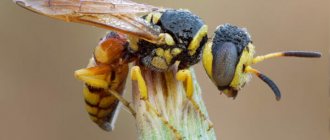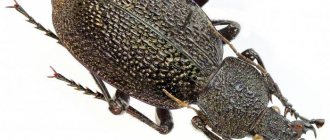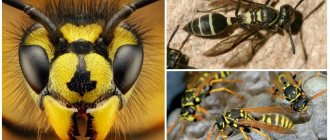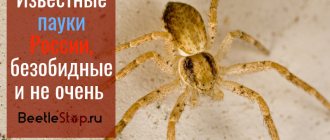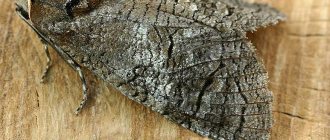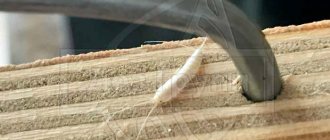Description
The bread ground beetle is one of the most common representatives of the order of Coleoptera insects, which make up the largest family of beetles (about 50,000 species):
- adults grow up to 2.5 cm;
- have an oval-shaped convex body, painted black with a slightly pronounced metallic tint;
- the surface of the abdominal part of the beetle is brown in color.
The insect has resinous-black thread-like antennae and 5-segmented limbs. The convex elytra have relatively deep, finely punctuated grooves. The beetle has strong and at the same time blunt jaws at the ends. The ground beetle is pictured below.
Bread ground beetle
How to distinguish a beneficial ground beetle from a pest
Before you start treating an area for ground beetles, make sure that there are insect pests on it. Pay attention to their appearance:
- Plant-eating ground beetles have short and seemingly underdeveloped limbs, and a rather large body.
- The head of the pests is rounded, the jaw and mouth opening are small. After all, you don’t need a big jaw to chew snack foods.
- The lifestyle of ground beetles is inactive.
- Predatory species of ground beetles have a large body, massive limbs and a large jaw. This is necessary to quickly grab the victim.
It is necessary to exterminate only those insects that feed on plants or have a mixed type of diet. There is no need to kill predatory ground beetles, because they eat pests, thereby helping agriculture and gardeners.
Lifestyle and habitat
The ground beetle is nocturnal, hiding during the day in its shelter (under snags, stones or tree roots). If a ground beetle has settled in a house, it usually hides in the joints of old furniture.
In natural conditions, the favorite habitat of the ground beetle is fields of winter wheat, rye, barley, oats and even corn.
On a note!
The pest gnaws the scales of the ear, damaging the primordia of the grains and the already ripening grain. In the absence of grain crops, the beetle can satisfy its hunger even with leeks.
Features of character and lifestyle
Photo: Ground beetle
Most species of ground beetles lead a terrestrial lifestyle, preferring a layer of rotted fallen leaves or a layer of dry grass from last year. However, there are also ground beetles that live on plants, soil-borne or parasitic.
Most often, beetles make a shelter for themselves among fallen leaves, under stones, at the roots of trees, in the grass. Some species also live on tree branches at a height of up to three meters. The main conditions for their habitat are stable temperature, high humidity, and shade.
According to recent scientific observations, ground beetles are considered insects that live in small groups, which allows them to successfully hunt not only insects, but also larger prey, such as small lizards.
The lifestyle of ground beetles is mostly nocturnal, although there are exclusively diurnal species. With the onset of darkness, all members of a small family go hunting, and early in the morning, even before dawn, everyone hides in the shadows.
With the onset of autumn, in the middle zone this is approximately mid-October, when the average daily temperature is already low, ground beetles burrow into the ground to a depth of half a meter and hibernate. Around mid-March or a little later, depending on the weather, the beetles come to the surface and again continue their life cycle.
The lifespan of different types of ground beetles differs, and radically. For example, there are ground beetles that live only one year and produce only one generation of offspring during their short life. There are also species that live 2-5 years or more.
Reproduction
In the presence of favorable conditions of heat and humidity, bread ground beetles begin to actively mate, after which the females lay eggs (from 50 to 250 pieces) in the soil. Dry weather reduces the fertility of ground beetles.
Insect reproduction After 10-15 days, larvae are born and remain in the soil until frost occurs. They spend the winter there, building a shelter for themselves in the form of a hole. They resume feeding on winter crops until the pupation period. It takes about 3 weeks to form a pupa. One generation of beetles appears per year.
Methods of penetration of ground beetles into human dwellings
Beetles can be found not only on a summer cottage or near a house, but also in the apartments themselves.
- They can enter a person’s home with wood or street garbage.
- Pests are attracted to the smell of animal food. If you do not follow this point, most likely “uninvited guests” will appear in your home.
- Open windows and doors. During hot periods, it is advisable to install mosquito nets. Seal all door cracks with sealant.
- If there is antique furniture in the apartment, they like to live in such places. Window sills, frames, bolts in floors, and so on.
- Among other things, you can find them in food products (bulk).
Where do bugs come from?
A ground beetle can find its way into an apartment in the following ways:
- beetle larvae can be carried into the house on shoes;
- together with products: cereals, flour or potatoes;
- with wood for lighting a fireplace or heating a stove;
- An unpleasant odor and remains of animal food in a pet’s cage can attract the attention of insects;
- Considering that beetles always fly towards the light, they enter the house through windows not protected by mosquito nets.
When night comes, a pest that has crawled into the house goes in search of food, which can be cereals, as well as crumbs and leftover food left on the table. With its rustling sound, the beetle deprives you of sleep and rest, often falling from the ceiling onto the bed. If the insect’s attempt to get food is successful, then this is a favorable signal for reproduction. Therefore, when a ground beetle appears in the house, it is necessary to take urgent measures to combat it.
Baits and traps against wireworms
The wireworm is willingly “led” to all kinds of traps. This feature has long been successfully used by lovers of non-chemical pest control products.
- Take old (spoiled) potatoes and soak them in any insecticide for 24 hours. Then bury it in the ground in places where wireworms accumulate and mark these places with sticks. After two days, collect the potatoes into which the wireworm has crawled and destroy them.
- Place pieces of potatoes or carrots in an unnecessary glass jar with a capacity of up to 0.5 liters and bury them, leaving the neck at ground level. Both larvae and adults will fall into such an improvised trap. The latter, however, can fly away, so it’s better to cover the neck with paper - then it will be more difficult for the insect to get out.
- You can also string pieces of potatoes, beets and carrots onto a wire. In the spring, before planting vegetables, bury such a “kebab” in the ground to a depth of 10 cm along the entire length of the bed. After 2-3 days you will receive an excellent treat for chickens, consisting of larvae and vegetables.
- Click beetles hide during the day in moist and shady places. Lure them in the spring with piles of grass or manure, and a few days later, during daylight hours, collect them and throw them into the fire. Do the same in the fall, just let the grass and manure sit until the cold weather.
- The permanent location of wireworms is young seedlings of corn, oats, barley and wheat. 1.5-2 weeks before planting potatoes, you can sow a small number of these crops and then dig them up along with the pests. New plants can be planted throughout the summer by pre-treating the seeds with an insecticide. Wireworms die from such a poisonous treat. The main thing is not to forget that the plant is inedible and cannot be eaten.
How to get rid of bugs in an apartment
Destruction of beetles in the house It is quite simple to destroy the malicious pest of the fields.
- Before you get rid of ground beetles in your apartment, you first need to find the place where they live. Then do a general cleaning, placing all bulk products in sealed containers.
- To treat the habitat of bread beetles, you can use a vinegar or soda solution, or use insecticidal agents such as Dichlorvos, Karbofos or Fufanon.
- If cereals or flour are infected with ground beetles, it is preferable to get rid of them completely. If this is not possible, the products should be calcined in the oven for 20-30 minutes.
- You can also fight bread beetles using ultraviolet rays by heating contaminated products in the sun for 6 hours.
- Cold has no worse effect on pests. Air temperatures below 15 degrees are detrimental to insects.
- Use baits based on boric acid.
- Plants with a strong aroma can also fight the uninvited guest. These are cloves, garlic, bay leaf.
Fighting ground beetles
Before starting a war with insects, it is worth clarifying where the Red Book ground beetle lives. After all, certain species are protected and their elimination can have serious consequences. The main habitat of rare beetles is the Crimean Peninsula, but they can settle in any place suitable for climatic conditions. It is worth comparing the found insect with the ground beetle in the photo and make sure of its “pest” status.
Destroying a pest is not so easy. It is necessary to take on this matter with all tenacity and carry out chemical treatment two or three times. Then, once a month, carry out preventive actions in order to destroy the larvae remaining after the main cleaning.
To kill beetles, several methods are used simultaneously. For chemical treatment, it is worth purchasing dichlorvos and karbofos and using them together with a solution of ammonia or vinegar.
Vinegar and ammonia must be dissolved in water in a ratio of 1:2. Before you start processing your garden or vegetable garden, you need to take care of your personal safety. Need to purchase:
- respirator;
- latex gloves;
- plastic glasses with wide temples;
- special clothes or those that you won’t mind disposing of later.
After dry cleaning, all personal protective equipment must be washed in running water, dried and stored in a far corner or disposed of. If the fight against insects takes place in a residential area, then it is better to start with food processing.
It is better to bake the cereals in the oven at a temperature of at least 75 degrees and put them in an airtight container. Or subject to sharp deep freezing. All cabinets, pantry shelves and baseboards are treated with a vinegar solution.
It is recommended to use ammonia or chemical reagents only in areas where there is good ventilation. Before treatment, all family members and animals should be sent out of the house for a walk.
After the ground beetle is completely destroyed, you should not calm down. Preventative measures should be carried out quite often; it is almost impossible to destroy the entire colony of pests at once. Follow simple instructions:
- after purchasing groceries, especially vegetables and fruits, be sure to inspect the product for damage;
- regularly carry out general cleaning with vinegar, looking in and thoroughly rinsing every corner, especially in dark rooms;
- store cereals in airtight containers;
- Sometimes treat wooden furniture; pests can settle between the boards.
When starting to fight the ground beetle, do not overdo it. It is always worth remembering that such insects occupy an important stage in the food chain. Complete eradication of pests can have a negative impact not only on plants, but also on larger animals and birds that feed on these beautiful bugs.
How to protect crops on the field
The following methods will help you get rid of bread ground beetles from crop areas:
- Follow the rules of crop rotation.
- Harvest grain crops at early stages of ripening. Moreover, you should immediately remove straw from the field and plow the soil to a depth of at least 20 cm.
- Attract natural enemies: various parasitic and predatory insects.
- Use treated seeds for sowing. Spray young crops with insecticidal preparations in a timely manner.
- Use insecticides Aktara, Eforia, Cruiser during the period of active feeding of the larvae.
Symptoms of damage to grain crops by ground beetles
Corn ground beetle larva
Both ground beetles and their larvae damage grain crops. The larvae damage plants in spring and autumn. On winter crop seedlings, the larvae gnaw off the leaf parenchyma, after which only a lump of chewed up tangled veins remains. Plants that have been damaged by ground beetle larvae often die.
Corn ground beetles damage grain crops during the grain filling and milky ripeness phases. When feeding on grain, the beetles intensively gnaw the awns and scales. The beetles are capable of eating away the entire ear, weakening it. The beetles knock out undamaged grains to the ground, which leads to increased crop losses.
We fight the pest
If a ground beetle appears in the house, it is not very difficult to get rid of it. To begin with, the favorite place of this insect is identified. During general cleaning, these areas should be thoroughly cleaned. To prevent insects from moving somewhere else, do not leave leftover food on the table and immediately wipe up all the crumbs. It is recommended to throw out trash from the house every evening.
All insects need to eat, so all debris, crumbs and dust need to be removed
Surfaces on which beetles often run are wiped with insecticides - “Dichlorvos”, “Karbofos”. These products are sold in hardware stores. There are also more affordable homemade substances. The favorite places of ground beetles are treated with soda or vinegar, which are diluted with water.
To ensure that uninvited guests are destroyed faster, products stored in open areas must have airtight packaging.
About predators
Particularly common on the territory of our country is the common, forest or, as it is also called, garden ground beetle, the description of which is slightly different from the previous individual:
- is a mustachioed insect whose body length reaches up to 3 cm;
- the beetle has a dark graphite or brown color with a metallic sheen;
- in the area of the flaps there are oblong grooves with golden inclusions.
The predatory insect has powerful sickle-shaped jaws and fairly developed legs, which allows it to move quickly in search of food. It is these features that distinguish beneficial insects from pests: they have shorter legs and less protruding mandibles. And entomophages (beneficial bugs) are larger insects.
Beetles go hunting at night; during the day they try to hide in shelters under tree bark, fallen leaves or stones. Various garden and vegetable pests can become their victims: slugs, snails, caterpillars, as well as their larvae.
Having noticed a suitable prey, the predator attacks it, digging in with its jaws. After which the beetle injects a special liquid. Thanks to it, the tissue of the prey dissolves, turning into a semi-liquid mass. In this form, the beetle eats its prey.
The ground beetle larva is no less active predator; one might even say on the contrary, it has a much larger appetite. It has a worm-like appearance. It moves with the help of three pairs of very long thoracic legs. The young offspring live in the upper layers of the soil, turning into full-fledged beetles by autumn.
Adults of any type of predator live in the upper layer of soil or on its surface. Insects are adapted to different conditions. The lifespan of this type of beetle is from 3 to 5 years. During this period, insects mate several times.
Considering that one ground beetle destroys more than three hundred pests over the summer, the benefits brought by garden beetles are simply invaluable.
You should not pick up the beetle with your hands, as it has a defense mechanism. The insect attacks its attacker with a jet of pungent, specific-smelling liquid.
Preventive measures
Daily wet cleaning helps prevent the appearance of unpleasant creatures. After all, dust, dirt and crumbs attract uninvited guests. If any old furniture or wooden objects are brought into the house, it is recommended to pre-treat them with appropriate insecticides. You can also simply treat with water and vinegar or baking soda.
Vacuuming your floors frequently will reduce the amount of dust in your home, especially under furniture and in corners, and you will notice the difference immediately
The bread ground beetle loves to live in cereals, flour and potatoes. After purchasing cereals, it is recommended to inspect them and pour them into glass containers. Flour should be sifted before use. It also needs to be stored in an airtight container. It is better to sort and wash the potatoes.
Quite often, these beetles enter houses through open windows. Therefore, mosquito nets must be installed on them. They reliably protect the room from annoying insects.
These simple tips will help protect your living space not only from ground beetles, but also from other unpleasant guests. After all, it’s better to keep things clean than to look for ways to destroy them.
Prevention of cockroaches and beetles
To prevent an individual who accidentally runs into an apartment from wanting to stay there, you need to follow simple rules. For the most part, the efforts made relate to sanitary cleaning of the premises and blocking the entry routes of pests:
- Regular (at least 2 times a month) wet cleaning of the apartment. If you add a little table vinegar, ammonia, wormwood infusion, or calendula decoction to the water, beetles/cockroaches will avoid your home.
- Beetles/cockroaches will not reproduce when food is scarce. Therefore, everything edible is stored in the refrigerator, vacuum bags, and hermetically sealed containers. Replace the trash can with an analogue one with a tight lid. It will help prevent the appearance of beetles/cockroaches feeding on furniture by wiping surfaces with an alcohol solution, diluted acetone, and vinegar.
- Sealing the apartment. An easy way to prevent beetles and cockroaches from spreading throughout your home is to block existing access channels to your home. The first thing to start with is to install a grille with small holes on the ventilation. Small pests can crawl through, but they protect 100% from adults. If there are cracks in the walls, floors, or in the area of window frames, you need to plaster the gaps (it is better to pre-fill large holes with foam).
- Using special pest control pencils/crayons is a reliable way to kill and prevent the appearance of beetles/cockroaches.
- Do not leave windows open (especially on summer evenings). Many beetles (unlike cockroaches) are initially attracted to human homes by light. Mosquito nets will protect you from flying.
- Constantly visually inspect products brought into the room before putting them away on the shelf.
- Clothing and other textiles are another way for bugs/cockroaches to get into your apartment. It is recommended to wash new items at a temperature of at least 60 degrees and dry them completely in fresh air. After this, the new clothes do not pose any danger and can be put away in the closet with the rest of the wardrobe.
Most insects are repelled by a strong smell. Therefore, as a preventive measure, bags of aromatic herbs and spices are placed near the possible entry points of beetles resembling cockroaches. Lavender, mint, eucalyptus, bay leaf, anise and other aromatic spices are suitable.
No one is safe from the sudden appearance of beetles in an apartment. Cockroaches and other dangerous pests take up residence in humans. The first thing you should find out is the type of insect that attacked the home. The correct strategy for combating beetles depends on this.
- What cockroaches don't like
- Temperature of death of cockroaches

